
ISSN 1859-1531 - TẠP CHÍ KHOA HỌC VÀ CÔNG NGHỆ - ĐẠI HỌC ĐÀ NẴNG, VOL. 23, NO. 2, 2025 81
STUDY ON OPTIMIZATION OF AL6061 SPHERE SURFACE ROUGHNESS IN
DIAMOND TURNING BASED ON CENTRAL COMPOSITE DESIGN MODEL
AND GREY WOLF OPTIMIZER ALGORITHMS
NGHIÊN CỨU TỐI ƯU HÓA ĐỘ NHÁM BỀ MẶT CẦU AL6061 KHI TIỆN BẰNG
MŨI DAO KIM CƯƠNG SỬ DỤNG MÔ HÌNH THIẾT KẾ TỔNG HỢP TRUNG TÂM VÀ
THUẬT TOÁN TỐI ƯU HÓA ĐÀN SÓI XÁM
Le Thanh Binh, Duong Xuan Bien*, Ngo Viet Hung, Chu Anh My,
Hoang Nghia Duc, Nguyen Kim Hung, Bui Kim Hoa
Advanced Technology Center, Le Quy Don Technical University, Ha Noi, Vietnam
*Corresponding author: duongxuanbien@lqdtu.edu.vn
(Received: Nevember 29, 2024; Revised: Febuary 08, 2025; Accepted: Febuary 11, 2025)
DOI: 10.31130/ud-jst.2025.494E
Abstract - This paper presents optimization results of the Al6061
surface roughness in turning ultra-precision based on the central
composite design method (CCD) and the grey wolf optimization
algorithm (GWO). The experimental matrix is built with three
independent variables including spindle speed, feed rate and
depth of cut. With the experimental data, the roughness regression
model is established. The ANOVA module is used to evaluate the
quality of the regression model. The GWO algorithm is used to
optimize the roughness within the range of pre-determined
cutting conditions. The most reasonable cutting parameter set is
found to ensure that the surface roughness of the Al6061 material
reaches the smallest value. The influence of parameter pairs on
the roughness is analyzed specifically. The research results are of
great significance in improving the surface quality of Al6061
material in turning ultra-precision.
Tóm tắt – Bài báo trình bày kết quả nghiên cứu tối ưu hóa độ
nhám bề mặt cầu vật liệu Al6061 khi tiện siêu chính xác
(SPDT) dựa trên phương pháp thiết kế tổng hợp trung tâm
(CCD) và thuật toán tối ưu hóa đàn sói xám (GWO). Ma trận
thực nghiệm được xây dựng với ba biến độc lập gồm tốc độ
trục chính, tốc độ chạy dao và chiều sâu cắt. Với dữ liệu của
các thí nghiệm, mô hình hồi quy độ nhám được thiết lập. Modul
ANOVA được dùng để đánh giá chất lượng mô hình hồi quy.
Thuật toán GWO được sử dụng để tối ưu hóa độ nhám trong
phạm vi chế độ cắt được xác định từ trước. Bộ thông số cắt hợp
lý nhất được tìm ra nhằm đảm bảo độ nhám mặt cầu đạt giá trị
nhỏ nhất. Ảnh hưởng của các cặp thông số tới độ nhám được
phân tích cụ thể. Kết quả nghiên cứu có ý nghĩa quan trọng
trong việc nâng cao chất lượng bề mặt cầu vật liệu Al6061 khi
tiện siêu chính xác.
Key words - Single-Point Diamond Turning (SPDT); surface
roughness; spherical surface; CCD; GWO.
Từ khóa – Tiện kim cương đơn điểm; độ nhám; mặt cầu; CCD;
GWO
1. Introduction
In the field of ultra-precision machining, achieving a
surface with the desired roughness is a critical requirement
to enhance product quality and meet stringent technical
standards for the operating conditions of specialized
components such as optical lenses, lens molds, spherical
joints, spherical reflective surfaces, and more. Single-Point
Diamond Turning (SPDT) is an advanced machining
method widely used to produce highly precise surfaces (in
the nanometer scale) [1]. Diamond cutting tools are
employed in SPDT to achieve nanometer-level surface
finish with specific requirements such as nanometer-scale
edge sharpness and excellent wear resistance, allowing for
machining with extremely low dimensional accuracy and
surface roughness [2].
SPDT is commonly applied to machine non-metallic
materials (e.g., ZnSe, Ge, CaF2, Si) or non-ferrous metals
such as aluminum and copper. This technology meets the
demands for manufacturing high-precision components,
such as spherical surfaces for optical lenses [3], lens molds
[4], aluminum mirrors [5], and laser guidance systems [6].
Nowadays, SPDT has become increasingly popular,
particularly effective in machining spherical surfaces on
aluminum materials like Al6061. Studies [7] have
demonstrated the excellent machinability (including
surface roughness) of Al6061 spherical mirror surfaces
when altering vibration frequency branching during the
SPDT process.
Surface roughness is a critical technical parameter,
used to measure the surface's unevenness after machining
[8]. Numerous studies have focused on the technical
factors affecting surface roughness, employing various
predictive models, including the Response Surface
Methodology (RSM) [9], Artificial Neural Networks
(ANN) [10], and Adaptive Neuro-Fuzzy Inference
Systems (ANFIS) [11]. Additionally, various algorithms
have been used as tools to solve single or multi-objective
optimization problems based on specific input parameters
and conditions. Frequently applied algorithms include
Genetic Algorithms (GA) [12-14], swarm-based
algorithms (PSO, ACO) [15-16], and the Grey Wolf
Optimization (GWO) algorithm [17-21]. RSM and ANN
modeling [9-10] were described using 27 experiments,
where a first-order regression equation was developed to
predict surface roughness. Furthermore, the GWO
algorithm is widely used for optimizing parameters or

82 Le Thanh Binh, Duong Xuan Bien, Ngo Viet Hung, Chu Anh My, Hoang Nghia Duc, Nguyen Kim Hung, Bui Kim Hoa
technological processes. In [17], the GWO model was
utilized to optimize parameters such as temperature,
friction coefficient, and screw rotation speed in twin-
screw extrusion to minimize material loss due to wear. An
improved GWO algorithm with reduced computational
time, faster convergence, and higher accuracy was
proposed in [18] to optimize the rolling parameters of raw
materials. Additionally, the GWO algorithm has been
applied for tool wear prediction in SVR [19],
performance prediction for desalination plants [20], and
two-dimensional modeling of direct metal deposition
processes [21]. In addition, a study [22] proposed a
Genetic Gray Wolf Optimizer (GGWO) algorithm, which
combines the principles of Gray Wolf Optimizer (GWO)
with genetic algorithm operators to optimize wind farm
layout. Compared with other algorithms such as PSO,
ABC ACO, GGWO shows improved energy yield, faster
convergence, and better compliance with layout
constraints. The hierarchical leadership structure and
genetic operation of the algorithm enhance the
exploration and exploitation capabilities, outperforming
traditional optimization methods. In the study [23],
Mehdi compared the GWO algorithm with many other
optimization algorithms such as PSO, GA, HJ, or Hybrid
Methods in the context of building energy optimization.
The results have shown that GWO achieved a good
balance between convergence speed and solution quality,
surpassing many existing algorithms in building energy
optimization. Consequently, the GWO algorithm has
demonstrated its feasibility and effectiveness in
optimization studies alongside other popular algorithms.
In SPDT, three technological parameters: spindle
speed (n- rev/min), feed rate (F- mm/min), and depth of
cut (ap- µm), have a direct and significant impact on the
surface quality of the machined component. Taper-
cutting experiments [24] were applied to determine the
transition depth between ductile and brittle regimes
during SPDT machining of ZnSe spherical surfaces. The
results indicated that reducing the feed rate (F) could
achieve optimal surface roughness without introducing
surface defects.
In this study, a regression model was developed to
describe the relationship between the three SPDT
parameters and the surface roughness of Al6061 spherical
surfaces, based on the Central Composite Design (CCD)
experimental method. Accordingly, the optimal roughness
and the most suitable technological parameters were
identified using the Grey Wolf Optimization (GWO)
algorithm. The influence of parameter pairs on surface
roughness was visually investigated, serving as a
foundation for effective SPDT process control in the future
for Al6061 spherical surfaces, contributing to improving
the surface quality of ultra-precision products.
2. Research contents
2.1. Experimental design using the CCD model
2.1.1. Experimental model design
The primary objective of the experimental process is to
collect data on the surface roughness of spherical surfaces
corresponding to the technological parameters of different
machining conditions. The entire machining process for the
spherical surface of the Al6061 alloy workpiece was
conducted on the ultra-precision lathe Nanoform® X
(Figure 1) using a diamond cutting tool NN60R0635m
WGC-MS0454 (Figure 4). The Al6061 workpiece
(Figure 3) has the following geometric dimensions: height
h = 20 mm, outer diameter Ø = 30 mm, and spherical
radius R = 19.5 mm. The specifications of diamond-cutting
tool are presented in Table 1.
Figure 1. Nanoform® X ultra-precision
turning system
Figure 2. The 3D optical profiler
ZEGAGE PRO HR
Figure 3. Al6061 spherical surface
Figure 4. Diamond cutting tool NN60R0635mWGC-MS0454

ISSN 1859-1531 - TẠP CHÍ KHOA HỌC VÀ CÔNG NGHỆ - ĐẠI HỌC ĐÀ NẴNG, VOL. 23, NO. 2, 2025 83
Table 1. Cutting tool specifications
Specifications
Cutting
edge
radius
Rake
angle
Cutting
height
Primary
Clearance
Included
angle
Waviness
Dimensions
0.649
mm
-25o
7.475
mm
10o
60o
≤ 2 µm
Table 2. Chemical compositions of Al6061
Element
Mg
Si
Fe
Cu
Cr
Mn
Zn
Ti
Al
wt.%
0.99
0.55
0.33
0.20
0.12
0.10
0.08
0.03
Balance
The chemical compositions of Al6061 alloy [25] are
presented in Table 2.
The SPDT process of the spherical surface of the
Al6061 workpiece is illustrated in Figure 5. The workpiece
is mounted on a vacuum chuck and machined using various
cutting conditions within the experimental investigation
range. A high-pressure water nozzle (machine mist) is
employed to remove chips from the workpiece during the
machining process, ensuring the safety and integrity of the
spherical workpiece surface.
Figure 5. Lathe system, fixtures, tools, and workpieces
All measurements of surface roughness values after
SPDT were performed on the 3D optical profiler ZEGAGE
PRO HR (Figure 2). In this experiment, the workpieces
were placed on a flat support. The optical lens with the
camera was moved close to the position of the workpieces
and the surface was scanned (Figure 6). The experimental
surface roughness values summarized in Table 3 are the
average results of two surface roughness measurements at
two symmetrical positions on the spherical surface,
corresponding to each set of technological parameters.
Figure 6. Measurement on the 3D optical profiler
ZEGAGE PRO HR
Table 3. Measurement results of the spherical surface roughness
after machining
No.
Exp
n (rev/min)
F
(mm/min)
ap (µm)
Ra (nm)
1
1000
5
2
5.606
2
2000
5
2
4.428
3
1000
25
2
4.218
4
2000
25
2
4.114
5
1000
5
8
2.233
6
2000
5
8
2.965
7
1000
25
8
6.131
8
2000
25
8
6.770
9
823.44
15
5
6.959
10
2176.56
15
5
4.345
11
1500
1.47
5
3.766
12
1500
28.53
5
5.480
13
1500
15
0.94
4.795
14
1500
15
9.06
7.228
15
1500
15
5
7.234
16
1500
15
5
6.820
17
1500
15
5
6.808
2.1.2. Central Composite Design (CCD) method
The Central Composite Design (CCD) method [26] is
an experimental design technique widely used in research
to construct experimental models, analyze data, and
optimize processes. In this study, seventeen experiments
measuring the surface roughness of spherical surfaces after
SPDT were conducted, incorporating three technological
parameters: depth of cut ap (µm), feed rate F (mm/min),
and spindle speed n (rev/min). After performing SPDT
according to the CCD experimental matrix and measuring
the surface roughness Ra, data analysis and model
construction were conducted. Statistical software DESIGN
EXPERT was used to analyze the collected data. A
quadratic regression model was developed to predict
surface roughness based on the technological parameters.
The encoded factor matrix for the CCD experimental
design with three factors and the corresponding ranges of
technological parameters are presented in Table 4. In the
CCD model, factors are assigned high levels (+1), low
levels (-1), or central levels (0). Additionally, the central
point spacing with orthogonal quadratic design α = 1.353
was selected to ensure that the regression parameters
(linear, interaction, and quadratic) are uncorrelated. This
enhances the accuracy of data analysis and ensures precise
evaluation of the regression model's suitability.
Table 4. Technological parameter ranges
Tech.
Parameter
Corres.
Variable
Low.
(-1)
Cen.
(0)
High
(+1)
n (rev/min)
A
1000
1500
2000
F (mm/min)
B
5
15
25
ap (µm)
C
2
5
8
Figure 7 illustrates the distribution of experimental
points in the CCD model. It can be observed that, with the
number of experiments N = 17 and the number of

84 Le Thanh Binh, Duong Xuan Bien, Ngo Viet Hung, Chu Anh My, Hoang Nghia Duc, Nguyen Kim Hung, Bui Kim Hoa
influencing factors k = 3, the experimental points are
arranged around a cube, with three points located at the
center. Six experiments represent axial points, whose
distance from the cube is defined by the encoded value
α = 1.353, and the remaining eight experimental points are
distributed at the vertices of the cube.
Figure 7. Experimental distribution in the CCC model
The specialized software DESIGN EXPERT was used
to construct the regression equation based on the CCD
experimental model with three input technological
parameters. Figure 8 demonstrates the high reliability of
the regression model. The coefficient of determination R2
[27] is 0.8754, indicating a strong fit between the model
and the experimental data. Furthermore, an Adeq Precision
value greater than four 4 indicates that the model is
adequate for navigating the design space.
Figure 8. Analysis of model fit with experimental data
Figure 9. Results of ANOVA analysis and regression coefficients
Figure 9 illustrates the ANOVA analysis results and the
coefficients of the regression equation. At a significance
level p-value < 0.05, the selected terms are x2, x2.x3, x12, x22.
The term x12 with p-value = 0.0764 < 0.1 belongs to the
range of significance values and can be used to describe the
effect of spindle speed on surface roughness.
Consequently, the regression equation for surface
roughness (Ra - nm) in terms of coded variables is
determined as follows:
22
2 2 3 1 2
6.92 0.7135 1.18 0.6724 1.23
a
R x x x x x= + + − −
(1)
The surface roughness after UPT is significantly
influenced by three technological parameters: spindle
speed n (rev/min), feed rate F (mm/min), and depth of cut
ap (µm). Figure 10 evaluates the effects of these
parameters on surface roughness. The curvature of the
graph reflects the rate of change in surface roughness with
respect to each parameter, indicating whether the change is
rapid or gradual.
It can be observed that the surface roughness value
Ra (nm) is minimally influenced by spindle speed n
(rev/min). However, feed rate F (mm/min) and depth of cut
ap (µm) have a significant impact on surface roughness.
Specifically, roughness increases with an increase in feed
rate F and decreases with an increase in depth of cut ap.
Figure 10. Influence of parameters on surface roughness
The above evaluations are qualitative assessments
based on observations of the graph and the regression
model. In fact, the technological parameters inherently
interact with each other and collectively influence surface
roughness. Moreover, experimental results are subject to
external noise factors that affect the surface roughness
measurements. Therefore, it is essential to design an
optimization problem to confirm the relationship between
surface roughness and the associated technological
parameters.
2.2. Optimization design using GWO algorithm
2.2.1. Grey Wolf Optimization (GWO) algorithm
The Grey Wolf Optimization (GWO) algorithm,
inspired by the predatory behavior of grey wolves, was
introduced by Mirjalili et al. [28] and has been widely
applied in various fields. In GWO, the grey wolf pack is
classified into four main roles: Alpha (α), Beta (β), Delta
(δ), Omega (ω). Each role contributes to the phases of
encircling, attacking, and searching for prey within the
search space to find the optimal solution.
The hunting process of grey wolves consists of three
main phases: encircling, searching for prey, and attacking
prey. In the GWO algorithm, these phases are modeled and
integrated into its steps. The steps and conditions required
to implement the GWO algorithm are shown in Figure 11.
Phase 1: Encircling Prey
The position of the wolves around the prey is adjusted
using the following equations:
. ( ) ( )
P
D C X t X t=−
(2)

ISSN 1859-1531 - TẠP CHÍ KHOA HỌC VÀ CÔNG NGHỆ - ĐẠI HỌC ĐÀ NẴNG, VOL. 23, NO. 2, 2025 85
( 1) ( ) .
P
X t X t A D
+ = −
(3)
The coefficient vectors
A
and
C
calculated with
vector
a
decreases linearly from 2 to 0 over iterations, and
vector
r
are random vectors in [0, 1].
2. . ; 2.A a r a C r= − =
(4)
Phase 2: Searching for Prey
Grey wolves can identify the position of the prey and
encircling it. The hunt is primarily guided by Alpha, with
Beta and Delta providing support. The remaining wolves,
known as Omega, update their positions based on the three
leaders. The following equations illustrate this process:
12
. ; .D C X X D C X X
= − = −
(5)
3 1 1
. ; .( )D C X X X X A D
= − = −
(6)
2 2 3 3
.( ); .( )X X A D X X A D
= − = −
(7)
1 2 3
( 1) 3
X X X
Xt ++
+=
(8)
Phase 3: Attacking Prey
When the distance between the wolves and the prey
becomes sufficiently small, the wolves attack the prey. In
the GWO algorithm, this process is simulated by reducing
the value of the vector
a
from 2 to 0, thereby reducing the
value of the vector
A
and narrowing the distance between
the wolves and the prey.
Figure 11. Algorithm implementation steps in GWO
2.2.2. Optimization results and discussion
The optimization problem for spherical surface
roughness is considered, with the objective function
derived from the established regression equation. The goal
is to determine the optimal technological parameters to
minimize the spherical surface roughness during
machining.
The GWO algorithm was constructed under the
conditions:
1 2 3
1.353 , , 1.353x x x− +
, corresponding to
the technological parameter limits:
823.44 2176.56n
(rev/min);
1.47 28.53F
(mm/min);
0.94 9.06ap
(µm). The algorithm parameters are as follows: size
population
5
A
S=
, maximum iterations
100.
i
M=
The computational program was implemented using
MATLAB. The optimization results are as follows: the
optimal value was identified after the 8th iteration, achieving
a surface roughness of Ra = 0.312 (nm) (Figure 12) with the
encoded technological parameters: x1 = 1.353, x2 = -1.353,
x3 = 1.353, corresponding to the actual values: n = 2176.56
(rev/min), F = 1.47 (mm/min), ap = 9.06 (µm).
The dependence of the objective function on parameter
pairs is presented in Figures 13, 14, and 15.
Figure 12. The optimization value of surface roughness
Figure 13. Graph of the objective function
( , )
a
R ap F
Figure 13 evaluates the influence of depth of cut (ap) and
feed rate (F) on surface roughness. At the optimal spindle
speed x1=1.353 (n = 2176.56 (rev/min), the graph reveals
that variations in feed rate (F) and depth of cut (ap) have a
complex effect on surface roughness. When the feed rate (F)
is fixed, the surface roughness value decreases linearly to a
minimum point as the depth of cut (ap) increases.
Conversely, when the depth of cut (ap) is fixed, increasing
the feed rate (F) causes the surface roughness value to follow
a parabolic curve, initially increasing to a maximum point
before gradually decreasing. This indicates that the two
parameters are interdependent and simultaneously affect
surface roughness. In UPT, it is necessary to reduce the feed
rate (F) while increasing the depth of cut (ap) to achieve
optimal surface roughness value.
The dependence of surface roughness on spindle speed
(n) and feed rate (F) is shown in Figure 14. At the optimal



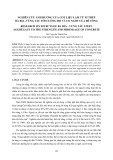
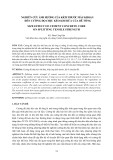
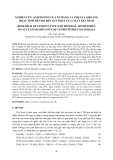
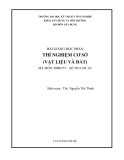



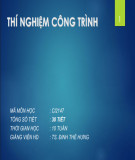

![Bài giảng Quản lý vận hành và bảo trì công trình xây dựng [chuẩn nhất]](https://cdn.tailieu.vn/images/document/thumbnail/2025/20251006/agonars97/135x160/30881759736164.jpg)









![Ngân hàng câu hỏi trắc nghiệm Sức bền vật liệu 1: [Mô tả/Định tính Thêm để Tăng CTR]](https://cdn.tailieu.vn/images/document/thumbnail/2025/20250920/kimphuong1001/135x160/6851758357416.jpg)


![Trắc nghiệm Kinh tế xây dựng [chuẩn nhất]](https://cdn.tailieu.vn/images/document/thumbnail/2025/20250920/kimphuong1001/135x160/32781758338877.jpg)
